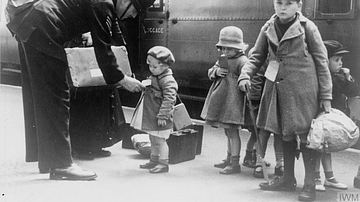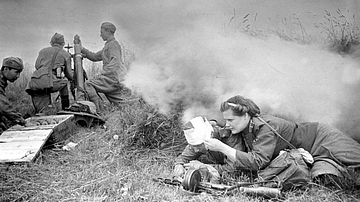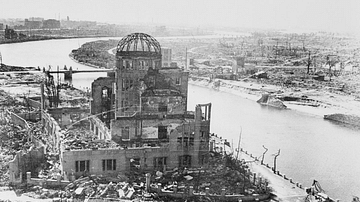Rationing of food, clothing, petrol, and other essential items was introduced in Britain during the Second World War (1939-45) when the country's imports were severely threatened by German U-boat attacks on merchant shipping in the Atlantic Ocean, North Sea, and English Channel. Citizens were issued with ration books of coupons which they could spend at retailers to ensure that everyone had access to a minimum of essentials but nobody could buy in excess of restricted amounts.
While some staples like bread, fruit, and vegetables were never rationed, plenty of other necessities were so that meals became simpler and more monotonous. Rationed items included meat, sugar, butter, cheese, tea, and soap. The government also encouraged people to use cheap restaurants by exempting them and their customers from any rationing. Although a black market developed where people illegally bought goods that were otherwise rationed, the ration system worked largely thanks to everyone's self-regulation.
Short Supplies
Pre-war Britain was heavily dependent on many imported goods, which came by ship from around the British Empire, North and South America, and other trading nations. Now during the war, merchant shipping came under serious threat from German U-boats as they headed to and from Britain. Another threat to supplies came from the German bombing of major British ports and the East End docks in London. With Western and Central Europe occupied by the enemy, Britain's access to goods produced there was cut off. In 1941, Britain's exports were two-thirds lower than before the war. Another blow to supplies came when Japan occupied parts of the British Empire in the East from 1942. In addition to these limits, the government's approach to total war meant that many resources had to be diverted to the war effort such as weapons manufacturing and transportation, further limiting resources that might otherwise have been used to support the market for domestic goods.
In order to ensure certain essential items remained available to the widest number of citizens, rationing was introduced, a policy that had been used in the First World War (1914-18). Food prices were controlled from November 1939. Petrol was rationed from September 1939. From the first months of 1940, meat, butter, and sugar were rationed. From June 1941, clothes were rationed in response to a dramatic rise in prices. Soap was rationed from February 1942 and became one of the most popular presents for Christmas that year.
There "is ample evidence that such controls, to help win the war, were not resented" (Dear, 882), and there was the benefit that people felt rationing, applied to everyone, was helping make British society less unequal as everyone pulled together in times of trouble.
Food Rationing
It is important to note that certain staple foods were never rationed. Unrationed food included bread, potatoes, fruit, vegetables, and fish. Of those rationed items, meat, butter, and sugar were the most important in terms of their level of consumption before the war. Individuals were regularly issued with a ration book in which were coupons they could only 'spend' at a designated shop (since shoppers first had to register with their local retailers). Once a coupon was spent on a particular item, an individual could not get more of the same until they received a new book. Customers still had to pay for their items, using money. The government paid people to observe that rationing was being respected in shops (by customers and shopkeepers), that portions in restaurants were correct, and that prices were being kept according to the Prices of Goods Act which aimed to reduce profiteering.
The height of rationing came in the summer of 1942 when the following weekly limits per person per week were imposed:
- 450 g (1 lb) of meat (monetary value 1s. 2d.)
- 113 g (4 oz) of ham and bacon
- 225 g (8 oz) of sugar
- 225 g (8 oz) of fats (e.g. butter)
- 225 g (8 oz) of cheese
Other items were rationed per person per month:
- 500 g (16 oz) of jam, marmalade, or mincemeat
- 225 g (8 oz) of sweets
Still other items were rationed every two months:
- dried eggs (equivalent to 12 fresh eggs)
On top of these, a person could save up and 'spend' some of their ration coupons on certain luxury items, those that were much scarcer and not deemed essential everyday staples. The shopper could save 20 points from their ration book and acquire their equivalent value in various goods such as breakfast cereals, biscuits, syrup, tinned salmon, and dried peas. 1 lb of dried peas cost one point while tinned salmon cost 32 points. A tin of peaches cost eight points and a tin of tomatoes six points. One can imagine much juggling was done by shoppers to get the best variety of foodstuffs with these bonus coupons. With frequent shortages and time-consuming coupon counting, another requirement was patience in the often long queues at shops.
Some people gained an extra allowance for some items. For example, a mother with a child under six years of age could have double the normal egg ration. Pregnant women and invalids were allowed one pint of milk a day. From July 1940, thanks to the national milk scheme, children under five and nursing mothers with a low income were entitled to a free pint of milk a day. A similar programme, the vitamin welfare scheme, was introduced in 1941, which gave children and mothers free orange juice and cod liver oil. The evacuation of children in wartime Britain to more plentiful rural areas at least helped to alleviate the strain on many urban households to provide them with the food and clothing they needed.
Many things became difficult or even impossible to acquire. Ice cream was forbidden. After November 1940, the government banned the importation of bananas. Oranges were almost impossible to find until the Allied victory in North Africa. Lemons were much sought-after but as rare as gold dust. Brussels sprouts became scarce. Certain wines, spirits, and beers became more difficult to buy in shops as the war went on, even pubs ran out at peak times like public holidays or in warm weather. Sometimes certain foods came and went, one week one's local grocer was full of a product and the next week empty, and so queues developed to buy the unexpected appearance of mundane items like onions, cauliflower, or gooseberries. As one shopper, Mrs Britton, noted in 1942: "Instead of going into a shop and saying 'I want so and so', we are all getting into the habit of saying 'Have you got…?'" (Ziegler, 252).
Changes in Eating Habits
People were encouraged by the Dig for Victory campaign to grow vegetables if they had a garden or an allotment and so supplement the nation's food store and their own larder. It is perhaps significant that one of the most popular genres in lending libraries throughout the war was books on gardening. Other statistics support the idea that the British became a nation of productive gardeners. Britain had 815,000 allotments in 1939, but four years later this number had risen to 1.4 million. Allotments sprang up in unlikely places, even the moat of the Tower of London was used to grow vegetables.
The government was also doing its bit to increase food productivity. Britain's land devoted to agriculture rose from 13.2 million acres in 1940 to nearly 18 million acres by 1944. Livestock figures, however, went in the opposite direction with sheep, pigs, and poultry greatly reduced (while cattle numbers remained stable). These official figures do not include those animals reared in private as many more people began to keep their own poultry and pigs. There was another change of habit, perhaps a more lasting one. Women usually prepared the meals in the family home, but a vast number had either been conscripted into the various military and auxiliary services or were working in factories, which meant they had less time for food preparation. This change and the lack of basic ingredients due to rationing led to an increase in demand for prepared meals in shops (what we would today call convenience foods), food like pies, cakes, and cooked meats which might previously have been made at home.
Another consequence of the rationing was that household cooks became skilled at providing varied menus with limited ingredients. Baking, in particular, reflected rationing with new recipes for cakes and puddings that did not require so many eggs (or any at all), had no fat, or contained less sugar than required by traditional recipes. Tinned meat imported from North America, such as spam, became a new feature of the British dining table. The government lent a hand, too, sponsoring some 200 short 'Food Flash' films, which gave tips on how to best use simple ingredients for more varied meals.
All of this rationing could have led to a depleted diet, but, in fact, the opposite happened as people ate less, perhaps, but generally more healthy food than before the war. "Overall there is no doubt that in terms of essential vitamins and calories, the UK's population was better fed in wartime than before, when malnutrition had accompanied unemployment and low wages" (Dear, 885).

The Appeal of Restaurants
The one place people could still enjoy a good nosh up was in a restaurant or canteen. Meals provided in the workplace, those offered in the new 200 or so cheap British Restaurants (which provided a three-course meal for nine pence), and food in other eating establishments were not subject to rationing. The government realised a safety valve to a strict rationing system was needed, and it was appreciated that many types of workers such as those in heavy industry would work better if they had access to extra portions of meat and cheese. An additional reason to avoid rationing food in restaurants is here given by the Liberal MP Dingle Foot:
The Ministry calculated that the more people ate out of their homes the better, because in fact less food is consumed. They therefore wanted to induce people to eat in restaurants and particularly to eat in canteens, and for that reason quite deliberately meals taken outside your home were exempt from rationing. The great difficulty we discovered was to get a great number of British workers to eat in canteens and many of them insisted on going home even though it meant eating up the family rations.
(Holmes, 394)
A consequence of allowing restaurants to be exempt from rationing was that wealthy people could eat their fill of anything they liked while the poor could not even afford to go. The government recognised this ill feeling in society by imposing a limit on how much a restaurant could charge per meal. Imposed from June 1942, the limit was five shillings. Government inspectors ensured restaurants complied with the rule, but many of the more expensive establishments got around the limit (and so were able to provide customers with more food) by adding service charges and increasing their prices for wines.
Clothes Rationing
The rationing of clothes was aimed primarily at reducing sales and so freeing up factory workers who could then be employed in areas of more direct use to the war effort. Oliver Lyttelton, President of the Board of Trade in 1940 and 1941, explains:
It was quite simple – the difference between rationed clothes and free clothes is four hundred and fifty thousand workers, simply that…and people were glad to be a little bit shabby and felt they were doing their stint.
(Holmes, 394)
Another reason to ration clothing was to save on materials, as these were needed for military uniforms. Just as with food, items of clothing had a different value in ration coupons, typically based on the quantity of material involved and the amount of work needed to make them. All items were purchased with cash plus the necessary coupons. An individual adult was issued with a clothes ration book which contained 66 coupon points (although this was reduced in 1945). New mothers received additional coupons, and children, because they wore out clothes faster than adults, were entitled to 76 coupons. Another category entitled to a little extra was workers who required clothing for their jobs such as protective clothing for manual workers or costumes for theatrical performers.
The clothing ration book had to last a year. Stockings required two coupons, trousers required eight coupons, and a dress required eleven. Shoes required five coupons for women's and seven for men's. Much juggling of necessity versus coupons available was required when shopping. One way to get extra coupons was to give away used clothing, particularly items that children had outgrown. The Women's Voluntary Service (WVS) organised centres where people could bring old clothes to get coupons or exchange them for second-hand clothes.
The government encouraged people to use as best they could those goods they were eligible to buy. Materials were also saved by the government's utility clothing schemes which invited designers to come up with simpler clothing that could be made more cheaply using less material than previous fashions. There were poster campaigns to remind people not to waste things and to 'make-do and mend', encouraging people to repair their clothes rather than buy new ones. Parents were encouraged to buy larger sizes for their children so that the clothes lasted longer. There were even pamphlets issued with tips on just how to make clothes last longer. People were also encouraged to make their own clothes, although fabrics also required coupons. Recycling fabrics to make clothes became a necessity for some, with curtains (including blackout curtains) and furniture coverings becoming a popular source of raw material. Classes were offered by local authorities on how to make and repair clothing, and it is significant that darning thread was never rationed. Knitting was encouraged, too, not only to make clothing but as a useful way to pass the time spent in an air raid shelter.
A lasting consequence of clothes rationing and the inevitable simplification of clothing and mass production of certain designs was that casual and more practical clothes became the norm, rather than the often more complex formal clothing seen before the war.
The Black Market
A thriving black market developed where people of all classes – if they knew the right people – could acquire things that were scarce or beyond the scope of their ration books. Such mundane items as eggs, meat, or a little extra petrol were all bought illegally, even if the vast majority of people did not really see this as breaking the law. One housewife, Ruth Tanner, explains: "I don't think anybody thought of it as blatantly criminal, it was just the way we lived" (Levine, 261). There was also a black market for ration coupons, with poorer families, who could not afford the goods anyway, especially tempted to sell some of their coupons to others. There could be prison sentences for those caught by the police, but the temptation and self-interest of everyone in the chain from wholesaler to consumer ensured there was not much the authorities could do to stop illegal trading. Petty crime also rose as scarcity drove people to steal from allotments, loot bombed-out shops, pilfer from warehouses, and make false claims for lost ration books.
The End of Rationing
Pressure on the UK was reduced following the US policy of Lend-Lease, that is offering aid (at a price) in the form of food, fuel, and material resources, and, more significantly, after the increase in US merchant shipping and warships to protect them in the Atlantic. Military victories which secured lost territories and made trade possible again across parts of the British Empire also helped enrich Britain's imports.
The war did not end rationing, and in some cases, things got worse. Bacon and lard rations were further cut in 1945, bread was added to the ration list in July 1946, and the coupons allocated per person for clothing were reduced, too. Clothes rationing ended in March 1949. Rationing of food was gradually phased out, but the shopper was not completely free of the coupon system until 1954 when meat became one of the last items to finally become unrestricted.










